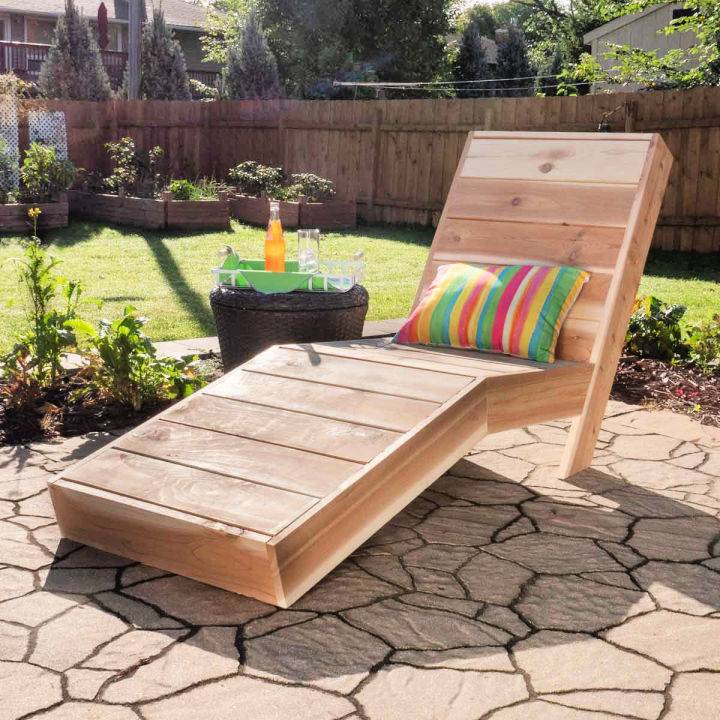Building a Cedar Lounge Chair: Diy Cedar Lounge Chair

Building a cedar lounge chair is a rewarding project that allows you to create a beautiful and durable piece of furniture for your home. Cedar is an excellent choice for outdoor furniture due to its natural resistance to rot, insects, and weathering. This guide will walk you through the steps of building a cedar lounge chair, from selecting the wood to finishing the piece.
Selecting and Preparing Cedar Wood
Cedar wood is available in various grades, each with its own characteristics and price. For a lounge chair, you will want to choose a grade of cedar that is strong and durable, such as select or better. When selecting your cedar, look for boards that are free of knots, cracks, and other defects. You should also check for any signs of insect damage or rot.
Once you have selected your cedar, it is important to prepare it for construction. This involves planing the boards to create smooth, even surfaces. You will also need to cut the boards to the correct dimensions for your lounge chair design.
Cutting and Joining the Cedar Pieces, Diy cedar lounge chair
Once you have prepared your cedar, you can begin cutting and joining the pieces to create the frame of your lounge chair. This step requires careful measurement and precise cuts to ensure that the chair is structurally sound.
Cutting the Cedar
Use a sharp saw or a table saw to make accurate cuts. For the chair frame, you will need to cut the cedar into various lengths and shapes. A detailed plan or blueprint is essential for this step.
Joining the Cedar Pieces
There are various joinery techniques you can use to join the cedar pieces together. Some common techniques include:
- Mortise and Tenon Joints: This is a traditional joinery technique that creates a strong and durable bond between two pieces of wood. The mortise is a rectangular hole cut into one piece of wood, and the tenon is a protruding piece of wood that fits into the mortise.
- Dovetail Joints: Dovetail joints are another strong and decorative joinery technique. The interlocking shape of the dovetail joints provides excellent strength and stability.
- Pocket Hole Joints: Pocket hole joints are a modern joinery technique that uses a jig to create angled holes in the wood. These holes are then used to insert screws, which create a strong and hidden joint.
The choice of joinery technique depends on your skill level and the desired look of the chair.
Fasteners for Cedar Lounge Chair
Proper fasteners are essential for ensuring the structural integrity of your cedar lounge chair. The type of fasteners you choose will depend on the joinery technique you use and the size and thickness of the cedar boards.
- Screws: Screws are a common fastener for cedar furniture. They offer good holding power and are relatively easy to use. When choosing screws, select those made of stainless steel or coated with a corrosion-resistant finish to prevent rusting.
- Nails: Nails can be used for some applications, but they are not as strong as screws. If you choose to use nails, select galvanized or stainless steel nails to prevent rusting.
- Glues: Wood glue is an essential component of most joinery techniques. It helps to create a strong bond between the pieces of cedar. Use a high-quality wood glue designed for outdoor use.
Finishing the Cedar Lounge Chair
Once the chair frame is assembled, you can finish it with a protective sealant or stain. This will help to preserve the cedar and enhance its natural beauty.
- Sealants: Sealants are designed to protect the cedar from water damage, UV rays, and other environmental factors. There are various types of sealants available, including oil-based, water-based, and polyurethane sealants.
- Stains: Stains are used to color the cedar and enhance its grain pattern. Stains come in a wide range of colors and finishes, including transparent, semi-transparent, and solid stains.
When applying a sealant or stain, follow the manufacturer’s instructions carefully. Ensure the cedar is clean and dry before applying any finish. Apply the sealant or stain in thin, even coats, allowing each coat to dry completely before applying the next.
Building a DIY cedar lounge chair can be a rewarding project, offering a unique blend of natural beauty and personalized comfort. For inspiration and guidance on crafting the perfect lounge chair, check out this comprehensive guide on hay all about a lounge chair , which delves into the key elements of comfort and style.
Whether you’re seeking a classic design or a modern aesthetic, a DIY cedar lounge chair can become a cherished centerpiece in your outdoor space.
Building a DIY cedar lounge chair can be a rewarding project, allowing you to personalize your outdoor space with a touch of rustic charm. If you’re seeking inspiration for your design, consider the iconic mid century danish lounge chair , renowned for its sleek lines and ergonomic comfort.
The Danish design philosophy emphasizes functionality and simplicity, which can translate beautifully into a cedar lounge chair, adding a touch of modern sophistication to your backyard haven.